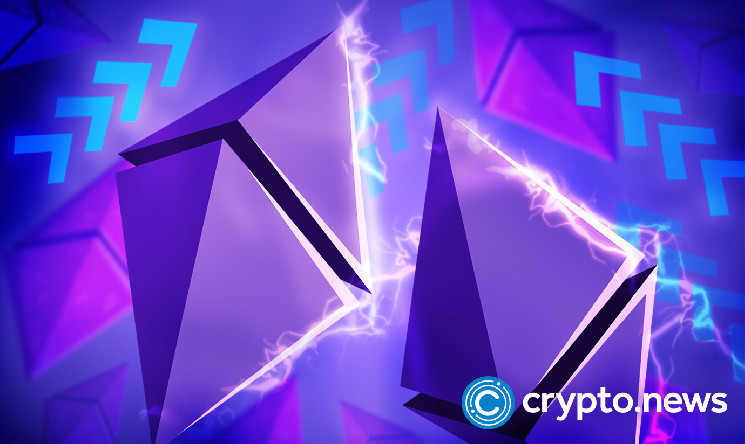Ethereum Throughput to Rise by over 5000X After the Merge

Vitalik Buterin, the co-founder of Ethereum, has said his network will eventually process 100,000 transactions per second after the development team completes the four-stage post-merge roadmap.
Ethereum 2.0 Will Be Highly Scalable
During the Ethereum Community Conference (EthCC) in Paris, France, Vitalik exuded confidence that the final Ethereum 2.0 version, powered by a proof of stake consensus mechanism, will be far more scalable than the current proof-of-work network. At optimum, Ethereum currently processes at most 20 transactions per second, causing a bottleneck and forcing miners to hike processing fees. This is despite the activation of EIP-1559, which saw Ethereum overhaul its fee model, to tame miners who prioritized processing transactions posted by users willing to pay more.
Comparing Ethereum with Bitcoin, Vitalik said the smart contracting platform is at 40 percent complete. However, once they activate the Merge and shift to a staking system, the platform will move a notch higher in its long-term development roadmap to be 55 percent complete. The Merge will bring together the proof of work mainnet with the Beacon Chain—the proof of stake blockchain currently running in parallel with the energy-intensive layer.
Ethereum’s Roadmap Post Merge
The transition date is September 19, 2022, after which Ethereum will be more robust and decentralized. Meanwhile, since Ethereum’s daily demand is projected to remain unchanged, ETH prices will likely rally since the network’s algorithm will slash daily emissions by 90 percent from 15k ETH to 1.5k ETH.
In Paris, Vitalik outlined four more development phases, dubbed the “surge, verge, purge, and splurge”, that will be implemented by developers over the next few years after the Merge to turbocharge Ethereum scaling capability and cement the platform’s position as a go-to platform for dApp deployment.
In the next phase scheduled after the Merge from 2023, dubbed “The Surge”, Ethereum will implement on-chain scaling through Sharding. Afterward, during “The Verge”, developers will release an enhanced version of the Merkle proofs, called Verkle Trees, to optimize the network’s storage and reduce node size. This stage set the foundation for “The Purge”, an upgrade that drastically minimizes hard disk size for node operators, effectively streamlining storage and reducing network congestion. In the last phase, “The Splurge”, developers will carry out miscellaneous and minor upgrades primarily for optimization, ensuring that the Ethereum 2.0 functions as designed after all the four stage main upgrades have been made.
Scaling Is a Critical Step Forward
Considering network activity and the number of apps launched, Ethereum is the home of DeFi and NFTs. On July 23, trackers show that Ethereum-based protocols dominate over 70 percent of DeFi TVL. Meanwhile, most high-value and rare NFTs are launched on the first smart contracting platform. Because of the high on-chain activity, Ethereum’s block space utilization is consistently upwards of 96 percent, explaining the relatively high Gas fees compared to other layer-1 networks like Solana. The high demand for block space has pushed the average Gas fees in some layer-2 solutions like Arbitrum higher than fees in competing, highly scalable layer-1 platforms.






 Bitcoin
Bitcoin  Ethereum
Ethereum  Tether
Tether  USDC
USDC  TRON
TRON  Dogecoin
Dogecoin  Cardano
Cardano  Bitcoin Cash
Bitcoin Cash  Chainlink
Chainlink  LEO Token
LEO Token  Stellar
Stellar  Monero
Monero  Litecoin
Litecoin  Zcash
Zcash  Hedera
Hedera  Dai
Dai  Cronos
Cronos  OKB
OKB  Tether Gold
Tether Gold  Ethereum Classic
Ethereum Classic  KuCoin
KuCoin  Gate
Gate  Algorand
Algorand  VeChain
VeChain  Cosmos Hub
Cosmos Hub  Dash
Dash  Stacks
Stacks  Tezos
Tezos  TrueUSD
TrueUSD  IOTA
IOTA  Basic Attention
Basic Attention  Decred
Decred  Theta Network
Theta Network  NEO
NEO  Synthetix
Synthetix  Qtum
Qtum  Ravencoin
Ravencoin  0x Protocol
0x Protocol  DigiByte
DigiByte  Nano
Nano  Zilliqa
Zilliqa  Siacoin
Siacoin  Holo
Holo  Numeraire
Numeraire  Waves
Waves  Ontology
Ontology  Status
Status  Enjin Coin
Enjin Coin  Pax Dollar
Pax Dollar  BUSD
BUSD  Hive
Hive  Lisk
Lisk  Steem
Steem  Huobi
Huobi  NEM
NEM  OMG Network
OMG Network  Augur
Augur  Bitcoin Gold
Bitcoin Gold  Ren
Ren  HUSD
HUSD